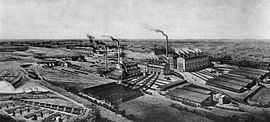Donatus Pit
| Donatus Pit | |||
|---|---|---|---|
| General information about the mine | |||
| The Donatus briquette factory (around 1897) | |||
| Mining technology | initially underground mining , later opencast mining | ||
| Information about the mining company | |||
| Start of operation | 1889 | ||
| End of operation | 1951 (underground mining) 1961 (opencast mining) |
||
| Funded raw materials | |||
| Degradation of | Brown coal | ||
| Geographical location | |||
| Coordinates | 50 ° 48 '15.5 " N , 6 ° 50' 58.1" E | ||
|
|||
| Location | east of Liblar | ||
| local community | Erftstadt | ||
| District ( NUTS3 ) | Rhein-Erft district | ||
| country | State of North Rhine-Westphalia | ||
| Country | Germany | ||
| District | Rhenish lignite district | ||
The pit Donatus is a former brown coal - mining in the Ville east of Erftstadt - Liblar . In the mine, the coal was first extracted underground and later in open-cast mining . The main purpose of the pit was to supply the adjoining briquette factory of the same name .
The Donatussee was created from the remaining hole of the opencast mine after the closure in 1960 , the briquette factory west of the mine was completely demolished.
history
The mine goes back to Friedrich DOINET, in Zülpich the pit Eustachia operation with connected briquette. In 1857 DOINET filed a presumption one for a very large field at Liblar and received in 1861 the concession for the field, which he after the Saints Donatus , designated, the patron saint and namesake of his family alleged. However, since the economic situation of lignite had deteriorated noticeably in the meantime compared to Ruhrsteinkohle, the development of the field was not economical and it remained unscratched.
The concession subsequently changed hands several times and was finally auctioned in 1887 to the manufacturer Ernst Leutert from Giebichenstein near Halle (Saale) , who ran a mine in the Halle area . In 1889, together with a widow Prang from Xanten and a businessman Balthazar from Cologne, he founded the Brühl-Cologne lignite mine Donatus union , which finally started to open up the field. In the beginning - as was still common at the time - underground mining was carried out from inclined tunnels, but this turned out to be difficult.
In 1891 Steiger Martin Dasbach (father of Adolf Dasbach ) moved from the Brühl mine to the Donatus mine. Under his leadership, Donatus went over to open-cast mining , for which the mine - pioneering for the region - first used a steam-powered excavator from 1895 , which the mine acquired from the construction site of the recently completed Kaiser Wilhelm Canal . The overburden was used, among other things, for the construction of the Cologne Eifeltor freight station .
In 1892 the first briquette factory was opened on Donatus, to which two more were added by 1898. With the boom in lignite in the 1890s, Donatus became one of the most important employers in the structurally weak Liblar. The workforce at the mine and the briquette factory grew to around 750 and a workers' settlement in Donatus-Dorf (bottom left in the picture) was created.
After the death of the main owner Leutert, the Donatus- Kuxe changed hands frequently at the beginning of the 20th century, until Carl Gruhl (son of Hermann Gruhl ) acquired the majority in 1904 and Donatus merged his Gruhlwerke in 1907 . A short time later, in the following year 1908, the merger with Fortuna AG to form Rheinische AG for lignite mining and briquette production (RAG) took place .
In the 1940s, the minable seams were slowly charred. In 1948 the last coal was extracted from the open pit in the Donatus mine. In the final phase , a new Donatus- Tiefbau shaft was sunk on a trial basis , but this quickly turned out to be uneconomical and was thrown out again in 1952 .
From 1944 onwards, the briquette factories were increasingly supplied with coal from the more modern large open-cast mines in Brühl, the Roddergrube and the Brühl mine . In this way, the Donatus factory could continue to operate even after the Donatus mine had been charred until the coal supplies in Brühl ran out and the Donatus factory was closed in 1959. Along with the mine and the factory, the Euskirchener Kreisbahnen also largely ceased operations, for which the main occupation was the removal of the briquettes from Liblar.
literature
- Volker Schüler , Manfred Coenen: The DONATUS briquette factory 1890–1959. Historical representation of a briquette factory in the Liblar area . Documenta Berchemensis historica; Bd. 35. DHB pupil, Frechen 2004, DNB 988295040 .
Web links
Individual evidence
- ↑ a b c d e Fritz Wündisch: Memory of Donatus . In: Home calendar of the Euskirchen district . Schiffer, Rheinberg 1964, DNB 015111199 ( full text on wisoveg.de).
- ↑ Construction machinery - 1.) ERDBAU on ak190x.de
- ↑ Liblar at www.erftstadt.de (accessed April 10, 2016)
- ↑ Clemens Frhr. v. Fürstenberg: Last layer on the "Donatus" pit . In: Home calendar of the Euskirchen district . Schiffer, Rheinberg 1960, DNB 015111199 ( full text on wisoveg.de ).



